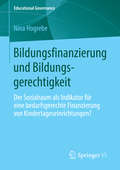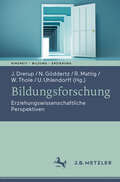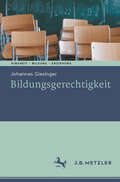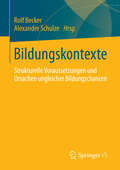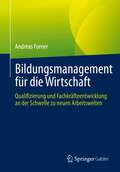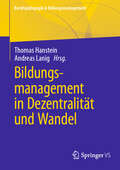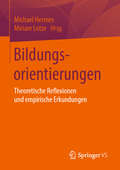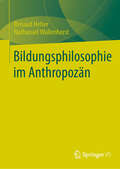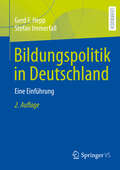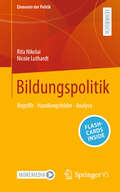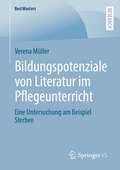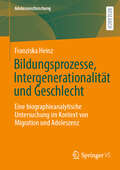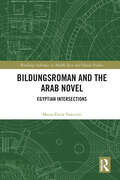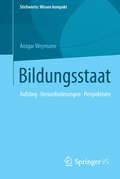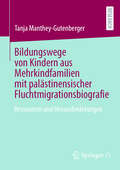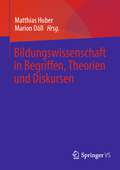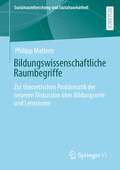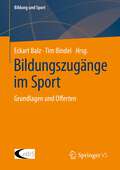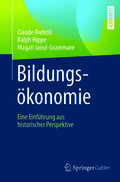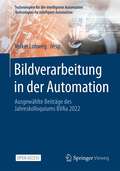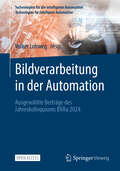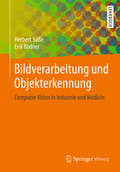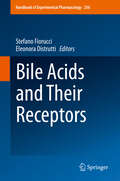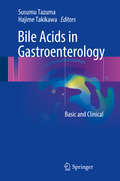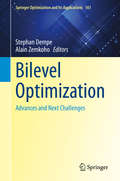- Table View
- List View
Bildungsfinanzierung und Bildungsgerechtigkeit: Der Sozialraum als Indikator für eine bedarfsgerechte Finanzierung von Kindertageseinrichtungen? (Educational Governance #24)
by Nina HogrebeDie Allokation von Ressourcen für die Erfüllung des Bildungsauftrages von Kindertageseinrichtungen ist Bestandteil einer politischen Regulierung von Rahmenbedingungen der pädagogischen Praxis - und mithin Teil der Educational Governance. Auf der Suche nach geeigneten Handlungsstrategien zum Abbau bestehender Bildungsdisparitäten ist der frühkindliche Bildungsbereich zunehmend in den Fokus der Auseinandersetzungen gerückt. Diese Studie untersucht das Verhältnis von Bildungsfinanzierung als politisch-administratives Steuerungsinstrument und Bildungsgerechtigkeit als zentrale pädagogische Leitkategorie frühkindlicher Bildung. Im Fokus steht die Frage, ob eine am Sozialraum orientierte Finanzierung von Kindertageseinrichtungen ein Instrument zur Erreichung einer Bildungsgerechtigkeit sein kann.
Bildungsforschung: Erziehungswissenschaftliche Perspektiven (Kindheit – Bildung – Erziehung. Philosophische Perspektiven)
by Johannes Drerup Werner Thole Nina Göddertz Ruprecht Mattig Uwe UhlendorffDer Begriff ‚Bildungsforschung‘ erweist sich als nicht minder umstritten als der Begriff der Bildung selbst. Bildungsforschung fungiert in der Diskussion häufig als eine Art Regenschirmbegriff, mit dem ein Forschungsprofil markiert wird, das es ermöglichen soll, schulische, insbesondere unterrichtsbezogene Bildungsprozesse empirisch zu erfassen und von Schüler*innen zu erwerbende Kompetenzen festzulegen und mit Hilfe quantitativer Verfahren zu evaluieren. Im Rahmen von anderen Forschungstraditionen geht man auf kritische Distanz zu diesem inhaltlich und methodisch allzu sehr eingeschränkten Verständnis von Bildungsforschung. Im Zentrum des Bandes stehen erziehungswissenschaftliche Zugänge und Beiträge zur Bildungsforschung und damit verbundene disziplinäre Perspektiven und forschungsmethodologische Fragestellungen.
Bildungsgerechtigkeit (Kindheit – Bildung – Erziehung. Philosophische Perspektiven)
by Johannes GiesingerIn unseren Bildungssystemen bestehen erhebliche soziale Ungleichheiten: Kinder aus sozial benachteiligten Familien sind schulisch weniger erfolgreich als Kinder wohlhabender und gebildeter Eltern, viele von ihnen erreichen minimale Kompetenzziele nicht. Ist das ungerecht? Dieses Buch nimmt eine normative Perspektive auf Ungleichheiten im Bildungsbereich ein. Es wird diskutiert, inwiefern es Sinn ergibt, Gleichheit (oder Chancengleichheit) anzustreben. Als Alternative wird eine Konzeption angemessener Bildung formuliert, nach der alle eine bestimme Schwelle in der Entwicklung relevanter Fähigkeiten entwickeln sollen. Die Tatsache, dass viele Heranwachsende heute diese Schwelle nicht erreichen, wird als die zentrale Bildungsungerechtigkeit dargestellt. Vor diesem Hintergrund wird das Problem der Begabtenförderung ebenso diskutiert wird die die Rolle von Privatschulen. Es geht um die Rechte der Eltern und das Wohl der Kinder, um die Digitalisierung der Schule und die Bedeutung von Bildungsgerechtigkeit für die Demokratie.
Bildungskontexte: Strukturelle Voraussetzungen und Ursachen ungleicher Bildungschancen
by Rolf Becker Alexander SchulzeGemäß dem meritokratischen Prinzip sollte alleine die Leistung eines Schülers, gemessen u. a. durch Schulnoten, dessen Bildungschancen bestimmen. Jedoch weist die umfangreiche empirische Bildungsforschung darauf hin, dass das deutsche Bildungssystem diesem Anspruch bei weitem und bis heute nicht gerecht wird. So belegen zahlreiche Studien ausgeprägte Ungleichheiten der Bildungschancenzwischen verschiedenen Sozialschichten und im Hinblick auf die ethnische Herkunft sowie das Geschlecht. Dabei gehen die angesprochenen empirischen Analysen (und die jeweils zugrunde liegenden theoretischen Konzepte) jedoch implizit häufig davon aus, dass alleine individuelle Determinanten für die festgestellten Bildungsungleichheiten ursächlich sind und es somit für die Bildungschancen vernachlässigbar ist, in welchem Klassen- und Schulkontext bzw. regionalem Umfeld oder sozialem Netzwerk sich eine Schülerin bzw. ein Schüler befindet. Neuere Untersuchungen auf Basis von Mehrebenenanalysen zeigen allerdings, dass auch die Bedingungen in den Klassen, Schulen und Regionen sowie die Lehrkräfte und die Zusammensetzung des Freundeskreises der Schüler einen erheblichen Einfluss auf den individuellen Bildungserfolg haben.
Bildungsmanagement für die Wirtschaft: Qualifizierung und Fachkräfteentwicklung an der Schwelle zu neuen Arbeitswelten
by Andreas FornerAngesichts neuer Arbeitswelten, demografischer Entwicklung, schnelleren Wissensumschlages und stärkeren Wettbewerbs spielt wirtschaftsnahe Qualifizierung und Weiterbildung in der Personalentwicklung eine große Rolle. Hieraus ergeben sich neue Notwendigkeiten, Arbeitsmarkt, Wirtschaft und Bildung noch stärker miteinander zu verbinden und Grenzen zwischen ihnen durchlässiger zu machen. Dieses Buch beleuchtet dabei die neuen Anforderungen in Analyse, Aufbereitung und Vorausdenken. Es trägt hierzu systematisch praktische Erfahrungen zusammen, verallgemeinert diese, setzt sich kritisch mit Verbesserungsbedürftigem auseinander und verfolgt dabei immer das Ziel, praktikable Lösungen aufzuzeigen. Es geht um die Anpassung bestehender Berufsbilder an neue Anforderungen, die Rolle der dualen betrieblichen Ausbildung und anderer Formate bei der Nachfrage von Betrieben, duale Ausbildung als Exportschlager, das künftige Verhältnis von hoch- und geringqualifizierter Beschäftigung und dem Sand im Getriebe des deutschen Weiterbildungssystems. Das Buch lebt von den umfangreichen praktischen Erfahrungen des Autors, die er verständlich formuliert und kommentierend in den größeren Zusammenhang überführt.
Bildungsmanagement in Dezentralität und Wandel (Berufspädagogik & Bildungsmanagement #1)
by Prof. Dr. Thomas Hanstein Prof. Dr. Andreas LanigDieses Buch veranschaulicht, wie dezentrale Bildungsstrukturen unterstützt werden können, um organisationale Prozesse zu optimieren und die ganzheitliche Persönlichkeitsentwicklung von Lehrenden und Lernenden zu fördern. Es bietet praxisnahe Einblicke in Modelle, Konzepte und Methoden, um Lernräume reflektiert, partizipativ und inspirierend zu gestalten. Durch Analysen, Fallstudien und methodische Vorschläge entsteht ein tragfähiger kollegialer Erfahrungsaustausch. Der Sammelband schlägt eine Brücke zwischen Schule, Hochschule und Bildungseinrichtungen des tertiären Sektors, um systemische und fachdidaktische Perspektiven zu reflektieren und zu verbinden. Dabei wird ein besonderes Augenmerk auf die Rolle von Lehrenden und Lernenden als interne Impulsgeber:innen und Gestalter:innen gelegt.
Bildungsorientierungen: Theoretische Reflexionen und empirische Erkundungen
by Michael Hermes Miriam LotzeAus der Perspektive qualitativ rekonstruktiver Forschung versammelt das Herausgeberwerk Beiträge zur Verortung von Bildungsorientierungen in Theorie und Empirie. Es entfalten sich unterschiedliche Facetten von Bildungsorientierungen. Schwerpunktsetzungen der Beiträge erfolgen u. a. mit Blick auf Bildungsinstitutionen und Familien sowie der Übergangs- und Ungleichheitsforschung. In der Gesamtschau der Beiträge wird die Heterogenität von Bildungsorientierungen auch in ihrer Relevanz für eine erziehungswissenschaftliche Forschung herausgearbeitet, die Bildungsprozesse – verortet in Lebensverläufen – zwischen Lebenswelt(en) und Institution(en) ergründet.
Bildungsphilosophie im Anthropozän
by Nathanaël Wallenhorst Renaud HetierDieses Buch entwickelt eine Bildungsphilosophie für das Anthropozän und schlägt vor, Bildung im Kontext der gegenwärtigen bioklimatischen Herausforderungen zu betrachten. Bildung wird als politisches Mittel der Wahl angesehen, um den unkontrollierbaren Wandel des Erdsystems einzudämmen und die Nachhaltigkeit menschlichen Lebens in der Gesellschaft zu gewährleisten. In diesem Buch setzen Hétier und Wallenhorst ihre Arbeit zur biogeophysikalischen und soziopolitischen Analyse des Anthropozäns fort und verfolgen den Weg zur Neugründung einer politischen Bildung, die die Studierenden darauf vorbereitet, die größte Herausforderung unserer Zeit anzugehen: das schrittweise Verschwinden der bioklimatischen Bedingungen, die für unser Überleben notwendig sind.
Bildungspolitik in Deutschland: Eine Einführung
by Stefan Immerfall Gerd F. HeppDieses Buch bietet eine systematische Einführung in grundlegende Fragen der Inhalte, Strukturen und Prozesse der Bildungspolitik in Deutschland, wobei die Steuerung der Schulpolitik und der Hochschulpolitik im Fokus der Darstellung stehen. Analysiert werden die zentralen Aufgaben- und Handlungsfelder sowie die Rahmenbedingungen, durch welche die bildungspolitischen Entscheidungen beeinflusst werden. Die neue Auflage wurde grundlegend aktualisiert und überarbeitet. Sie berücksichtigt unter anderem Änderungen in den Bund-Länder-Beziehungen, die gestiegene Bedeutung der frühkindlichen Bildung und die bundesweiten Bildungsprogramme.
Bildungspolitik: Begriffe - Handlungsfelder - Analyse (Elemente der Politik)
by Rita Nikolai Nicole LuthardtDas Lehrbuch bietet eine strukturierte Einführung in zentrale Begriffe von Bildungspolitik entlang des Zusammenspiels von polity, policy und politics für die Handlungsfelder der Schul- und Erwachsenenbildung. Darüber hinaus liefert das Lehrbuch einen Einblick in alle bildungspolitischen Handlungsfelder - von frühkindlicher Bildung und bis zum Lernen im Erwachsenenalter – anhand des Institutionengefüges, zentraler Akteure und bildungsrechtlicher Vorgaben. Der Band bietet einen kompakten Überblick und richtet sich an Studierende der Sozial- und Geisteswissenschaften sowie an alle, die sich für Bildungspolitik interessieren. Zusätzliche Fragen per App: Laden Sie die Springer Nature Flashcards-App kostenlos herunter und nutzen Sie exklusives Zusatzmaterial, um Ihr Wissen zu prüfen.
Bildungspotenziale von Literatur im Pflegeunterricht: Eine Untersuchung am Beispiel Sterben (BestMasters)
by Verena MüllerVerena Müller unternimmt den Versuch, eine Schnittstelle zwischen fiktionaler Literatur und der Pflegeausbildung herzustellen. Hierfür untersucht sie mit Blick in verschiedene Bezugswissenschaften, ob und wie der Einsatz von literarischen Texten den Weg zu einem ästhetischen Lernen im Pflegeunterricht bereitet. Dabei fokussiert sie exemplarisch den pflegerisch relevanten Zusammenhang von Tod und Sterben, um die Ausführungen zu rahmen. Dazu führt sie Erkenntnisse der Literaturdidaktik, der allgemeinen Erziehungswissenschaften und der Medical Humanities hinsichtlich des Einsatzes von literarischen Texten zusammen, setzt diese in Bezug zu den Zielen der Pflegedidaktik und leitet relevante Aspekte ab. Anknüpfend an die Ergebnisse zeigt sie in einer pflegedidaktischen Analyse zweier literarischer Texte beispielhaft pflegedidaktische Gewinne auf.
Bildungsprozesse, Intergenerationalität und Geschlecht: Eine biographieanalytische Untersuchung im Kontext von Migration und Adoleszenz (Adoleszenzforschung #15)
by Franziska HeinzFranziska Heinz widmet sich intergenerationalen Dynamiken in den Bildungsprozessen junger Frauen mit türkisch-deutscher Migrationsgeschichte. Ihre qualitativ-empirische Studie basiert auf narrativ-biographischen Interviews in zwei Generationen und fokussiert Zusammenhänge zwischen den biographischen Erfahrungen von Müttern und Vätern und deren Töchtern aus einer geschlechterkritischen Perspektive. Auf Basis der intergenerationalen Fallrekonstruktionen lassen sich verschiedene Bezugnahmen zwischen den adoleszenten Transformationsprozessen und Bildungsprozessen junger Frauen und den biographischen Erfahrungen, Bildungsaspirationen und generativen Haltungen ihrer Eltern im migrationsgesellschaftlichen Kontext beschreiben. Dabei werden sowohl biographische Herausforderungen als auch Ressourcen und Transformationspotentiale deutlich sowie deren gesellschaftliche Bedingungen.
Bildungsroman and the Arab Novel: Egyptian Intersections (Routledge Advances in Middle East and Islamic Studies)
by Maria Elena PaniconiThrough a close-reading of a corpus of novels featuring young protagonists in their path toward adulthood, the book shows how Bildungsroman impacted the formation of the Egyptian narrative. On a larger scale, the book helps the reader to understand the key role played by the coming of age novel in the definition and perception of modern Arab subjectivity. Exploring the role of Bildungsroman in shaping the canonical Egyptian novel, the book discusses the case of Zaynab by Muhammad Husayn Haykal (1913) as an example of early Arab Bildungsnarrative. It focuses on Latifa Zayyat’s masterpiece The Open Door and the novels of the 90es Generation, offering a gender-based analysis of the Egyptian Bildungsroman. It provides insightful readings about the function of the novel in women’s re-negotiation of social boundaries. The study shows how the stories of youth present universal themes such as the thwarted quest for love, the struggle for personal fulfilment, the desire to achieve a cultural modernity often felt as "other than self". The book is a journey in the Twentieth Century Egyptian Novel, seen through the lens of the transnational form of Bildungsroman. It is a key resource to students and academics interested in Arabic literature, comparative literature and cultural studies.
Bildungsstaat: Aufstieg • Herausforderungen • Perspektiven (Stichworte: Wissen kompakt #0)
by Ansgar WeymannDersouveräne Bildungsstaat garantiert Bildung als Bürgerrecht und als attraktivepersönliche Lebenschance. Er nutzt Bildung zur Förderung vonWirtschaftswachstum und Wohlstand in einer Welt mit internationalem Wettbewerbauf immer mehr Gebieten und als Mittel sozialer und kultureller Integration derBevölkerung. Der Bildungsstaatwurde zum Stolz der Nationen und zum beliebten Instrument des Wohlfahrtsstaatesmit ausgreifenden sozialpolitischenInanspruchnahmen, eine moderneZivilreligion mit scheinbar unerschöpflichen Heilsversprechen. Doch die Grenzendes Wachstums sind sichtbar: Bildungserträge stagnieren, soziale Ungleichheitbleibt dauerhaft, das internationale Medieninteresse an Bildung schrumpft. Hatder Bildungsstaat seinen Gipfel erreicht? Oder durchläuft er einenInnovationszyklus im Zuge nichtwestlicher Globalisierung?
Bildungswege von Kindern aus Mehrkindfamilien mit palästinensischer Fluchtmigrationsbiografie: Ressourcen und Herausforderungen
by Tanja Manthey-GutenbergerDiese Studie untersucht, wie die familiäre Konstitution von Mehrkindfamilien mit palästinensischer Fluchtmigrationsbiografie die Bildungswege ihrer Kinder beeinflusst. Befragt wurden junge Erwachsene, die in Deutschland mit vier oder mehr Geschwistern aufgewachsen sind und ihre Bildungslaufbahn weitgehend abgeschlossen haben. Die Analyse zeigt, dass strukturelle Gemeinsamkeiten über die Einzelfälle hinweg die Bildungsbiografien maßgeblich prägen. Besonders familiale Aspekte im Kontext von Flucht und Postmigrationsstress wirken sich auf das Aufwachsen und die Orientierung der Jugendlichen aus. Ein zentrales Ergebnis ist die Bedeutung des sogenannten fehlenden „juristischen Kapitals&“, das – im Zusammenhang mit der spezifischen palästinensischen Vertreibungsgeschichte – Bildungsentscheidungen zusätzlich beeinflusst. Dabei zeigt sich, dass diese Effekte je nach Geburtenfolge unterschiedlich stark ausfallen. Ebenso wird deutlich, wie elterliche Erwartungen im Spannungsfeld von Aufenthaltsdauer, rechtlichem Status und familialen Bedürfnissen die Rolle der Geburtenfolge unterschiedlich prägen.
Bildungswissenschaft in Begriffen, Theorien und Diskursen
by Matthias Huber Marion DöllIm vorliegenden Handbuch werden 84 pädagogische Begriffe, Theorien und Diskurse von 94 Vertreter*innen der Bildungswissenschaft vorgestellt und entlang ihrer historischen Entwicklung, aktuellen Positionen und zukünftigen Forschungsperspektiven kritisch diskutiert.Der Band stellt nicht nur ein breites Spektrum an theoretischen Bezügen, Grundbegriffen und Konzepten bereit, sondern ermöglicht überdies eine organisch-dynamische Rekonstruktion der bildungswissenschaftlichen Forschungslandschaft unter besonderer Berücksichtigung theoretischer Einsätze.In der Funktionalität eines komprimierten Nachschlagewerks erhalten Forschende, Lehrende, Studierende und Praktiker*innen klar strukturierte Texte, die eine Vielzahl derzeit relevanter pädagogischer und erziehungswissenschaftlicher Themen einführend vorstellen.
Bildungswissenschaftliche Raumbegriffe: Zur theoretischen Problematik der neueren Diskussion über Bildungsorte und Lernräume (Sozialraumforschung und Sozialraumarbeit #25)
by Philipp MatternDas gegenwärtige bildungs- und erziehungswissenschaftliche Interesse an Raum und Räumlichkeit ist enorm. Aber warum eigentlich? Und was genau ist mit Raum und Räumlichkeit gemeint, wenn von ihnen die Rede ist? Die wissenschaftstheoretisch ausgerichtete Studie analysiert die zentralen Entwicklungslinien und Diskussionsstränge einer äußerst vielschichtigen Debatte seit der Jahrtausendwende. Sie fragt nach Genese und Geltung grundgelegter Raumbegriffe und diskutiert den Entwurf einer materialistischen Theorie der Produktion bildungsbezogener Raumverhältnisse im Anschluss an Henri Lefebvre.
Bildungszugänge im Sport: Grundlagen und Offerten (Bildung und Sport #29)
by Eckart Balz Tim BindelIn dem Band werden konkrete Bildungszugänge für Kinder und Jugendliche auf den Feldern des Sports aufgezeigt. Solche Bildungszugänge fokussieren spezifische und z. T. auch niederschwellige Möglichkeiten einer Bildung im Sport und sollen adäquate Bildungschancen anbahnen: über bestimmte Bildungsinhalte und Bildungsmomente, Bildungsfiguren und Bildungsmedien, Bildungsorte und Bildungslandschaften. Hierzu werden orientierende Beiträge und viele gelungene Beispiele sich öffnender Bildungszugänge beigesteuert. Für alle Beteiligten im agonalen, informellen, kommerziellen und humanitären Sport können solche Offerten die Bildungsarbeit im Sport unterstützen.
Bildungsökonomie: Eine Einführung aus historischer Perspektive
by Claude Diebolt Ralph Hippe Magali Jaoul-GrammareDieses Lehrbuch über die Einführung in die Bildungsökonomie fasst die wichtigsten theoretischen und empirischen Arbeiten seit dem Entstehen des Forschungsfelds zusammen. Sie bietet damit einen kurzgehaltenen Überblick über die ökonomische Bedeutung der Bildung in ihren unterschiedlichen Ausprägungen. Sie ist ideal als Einstieg in diesen immer wichtiger werdenden Themenbereich geeignet. Darüber hinaus zeigt sie die sehr langfristige Bildungsentwicklung in Europa anhand neuester empirischer Daten auf. Der InhaltDie traditionelle HumankapitaltheorieDie konkurrierenden HumankapitaltheorienDie ArbeitsmarkttheorienDie Sichtweise der SoziologenDie Theorien der Anziehungskraft des ArbeitsmarktsHochschulsektor und GleichheitDie endogenen Wachstumstheorien Langfristiges Wachstum und BildungDie AutorenProf. Dr. Claude Diebolt ist CNRS Research Professor in Economics, esp. Cliometrics an der Universität Straßburg.Dr. Ralph Hippe ist Research Fellow im Joint Research Centre der Europäischen Kommission in Ispra.Dr. Magali Jaoul-Grammare ist CNRS Research Fellow in Economics an der Universität Straßburg.
Bildverarbeitung in der Automation: Ausgewählte Beiträge des Jahreskolloquiums BVAu 2022 (Technologien für die intelligente Automation #17)
by Volker LohwegIn diesem Open-Access-Tagungsband sind die besten Beiträge des 8. Jahreskolloquiums "Bildverarbeitung in der Automation" (BVAu 2022) enthalten. Das Kolloquium fand am 02. November 2022 auf dem Innovation Campus Lemgo statt.Die vorgestellten neuesten Forschungsergebnisse auf den Gebieten der industriellen Bildverarbeitung erweitern den aktuellen Stand der Forschung und Technik. Die in den Beiträgen enthaltenen anschaulichen Anwendungsbeispiele aus dem Bereich der Automation setzen die Ergebnisse in den direkten Anwendungsbezug.
Bildverarbeitung in der Automation: Ausgewählte Beiträge des Jahreskolloquiums BVAu 2024 (Technologien für die intelligente Automation #19)
by Volker LohwegIn diesem Open-Access-Tagungsband sind die besten Beiträge des 9. Jahreskolloquiums "Bildverarbeitung in der Automation" (BVAu 2024) enthalten. Das Kolloquium fand am 05. November 2024 auf dem Innovation Campus Lemgo statt. Die vorgestellten neuesten Forschungsergebnisse auf den Gebieten der industriellen Bildverarbeitung erweitern den aktuellen Stand der Forschung und Technik. Die in den Beiträgen enthaltenen anschaulichen Anwendungsbeispiele aus dem Bereich der Automation setzen die Ergebnisse in den direkten Anwendungsbezug.
Bildverarbeitung und Objekterkennung: Computer Vision in Industrie und Medizin
by Herbert Süße Erik RodnerDieses Buch erläutert, wie Informationen automatisch aus Bildern extrahiert werden. Mit dieser sehr aktuellen Frage beschäftigt sich das Buch mittels eines Streifzuges durch die Bildverarbeitung. Dabei werden sowohl die mathematischen Grundlagen vieler Verfahren der 2D- und 3D-Bildanalyse vermittelt als auch deren Nutzen anhand von Problemstellungen aus vielen Bereichen (Medizin, industrielle Bildverarbeitung, Objekterkennung) erläutert. Das Buch eignet sich sowohl für Studierende der Informatik, Mathematik und Ingenieurwissenschaften als auch für Anwender aus der industriellen Bildverarbeitung.
Bile Acids and Their Receptors (Handbook of Experimental Pharmacology #256)
by Stefano Fiorucci Eleonora DistruttiThis book focusses on the latest results related to the field of bile acids as signaling molecules and describes how these receptors have become a major pharmacological target. It covers all major areas of research in this field, from genetics, chemistry, in silico modeling, molecular biology to clinical applications, offering a cross-country view of the functional role of bile acids as signaling molecules, virtually acting on all major areas of metabolism. While FXR and GPBAR1 are essential bile acid sensors that integrate the de novo bile acid synthesis with intestinal microbiota and liver metabolism, in a broader sense, BARs play a pathogenic role in the development of common human alignments including liver, intestinal and metabolic disorders, such as steatosis (NAFLD) and steato-hepatitis (NASH), diabetes, obesity and atherosclerosis.
Bile Acids in Gastroenterology: Basic and Clinical
by Susumu Tazuma Hajime TakikawaThis book examines the biological aspects of bile acid analysis and their clinical applications, providing readers with an overview of cutting-edge discussions on Bile Acid research and diseases. It begins with detailed discussions on the biological aspects of bile acid, with chapters examining bile acid from various perspectives, from its metabolism to its use in therapeutic agents. Subsequent chapters focus on diseases involving bile acid abnormalities, and specific applications are addressed concerning gallstones, cholestatic liver disease, NAFLD/NASH, hepatitis, pancreatitis, esophageal cancer and colon cancer. In keeping with the book's integrated approach, the Editor has gathered a broad range of eminent scholars and practitioners to provide a comprehensive review of modern bile acid research. The book offers clinical physicians, basic researchers and postgraduate students essential insights into cutting-edge research and paves the way for further research.
Bilevel Optimization: Advances and Next Challenges (Springer Optimization and Its Applications #161)
by Stephan Dempe Alain Zemkoho2019 marked the 85th anniversary of Heinrich Freiherr von Stackelberg’s habilitation thesis “Marktform und Gleichgewicht,” which formed the roots of bilevel optimization. Research on the topic has grown tremendously since its introduction in the field of mathematical optimization. Besides the substantial advances that have been made from the perspective of game theory, many sub-fields of bilevel optimization have emerged concerning optimal control, multiobjective optimization, energy and electricity markets, management science, security and many more. Each chapter of this book covers a specific aspect of bilevel optimization that has grown significantly or holds great potential to grow, and was written by top experts in the corresponding area. In other words, unlike other works on the subject, this book consists of surveys of different topics on bilevel optimization. Hence, it can serve as a point of departure for students and researchers beginning their research journey or pursuing related projects. It also provides a unique opportunity for experienced researchers in the field to learn about the progress made so far and directions that warrant further investigation. All chapters have been peer-reviewed by experts on mathematical optimization.
